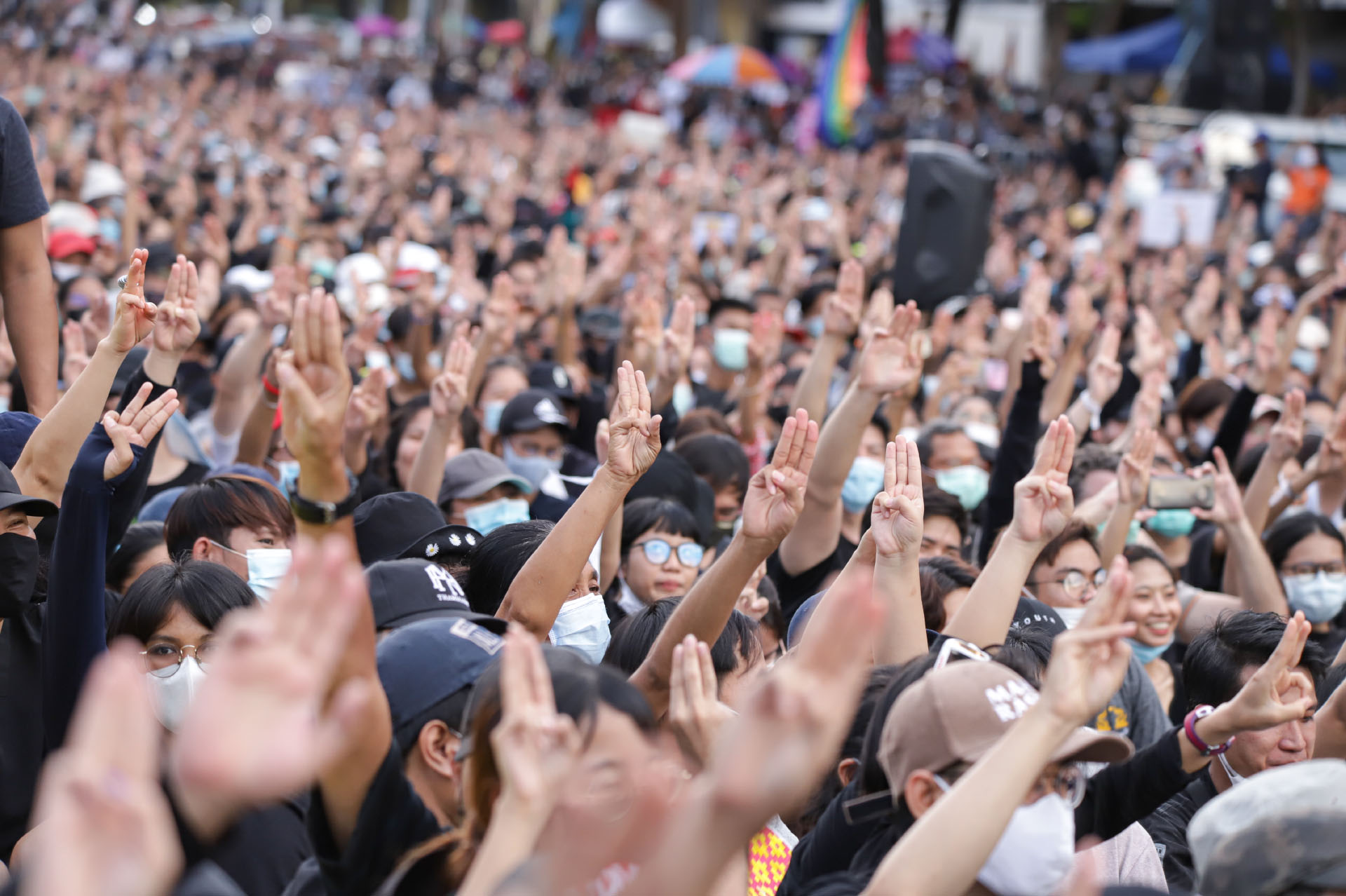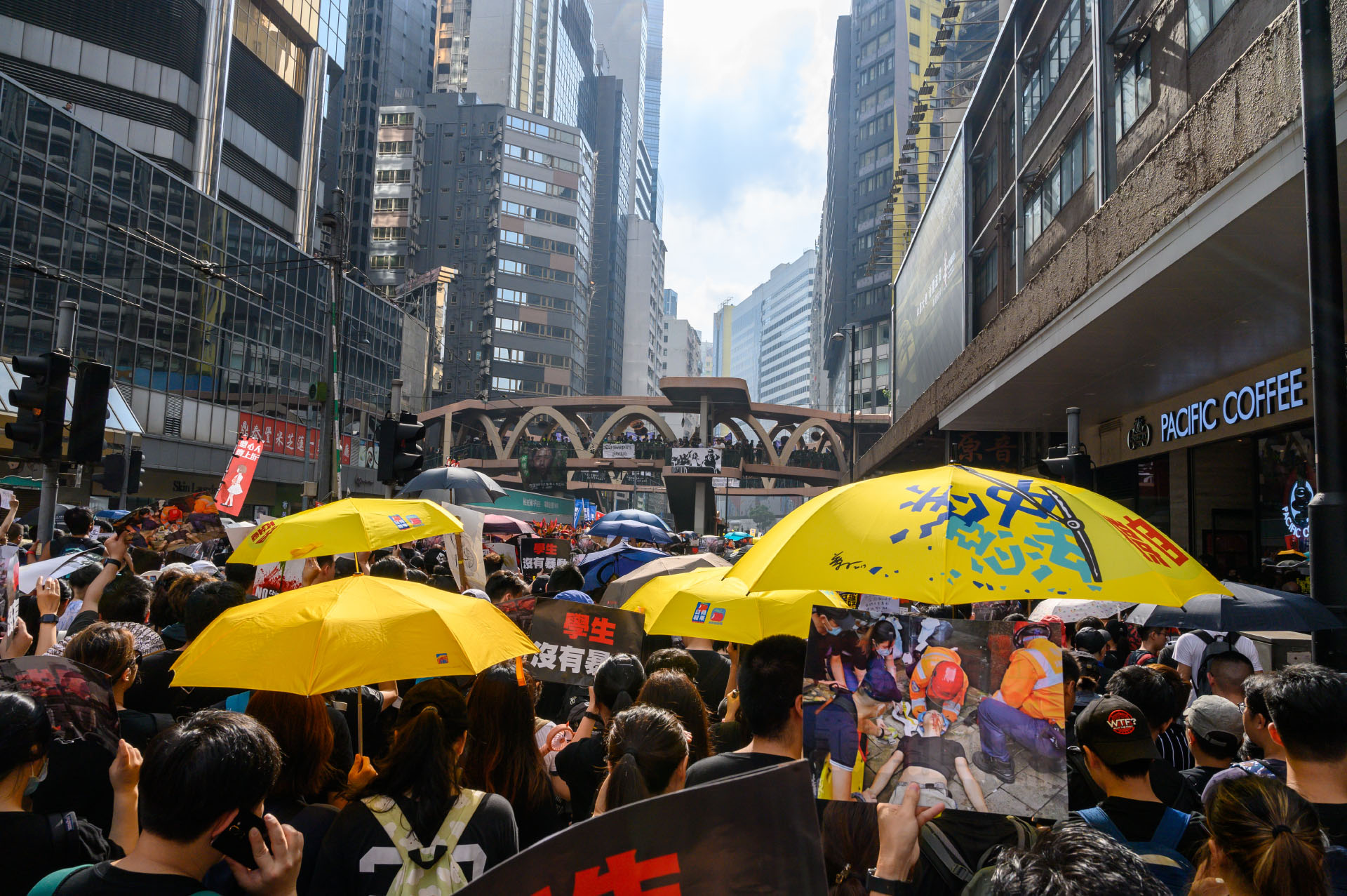|
Getting your Trinity Audio player ready...
|
This article is the eighth in a 10-part series collectively themed “Fostering Democracy Movements,” an Asia Democracy Network special 10th anniversary report produced by the Asia Democracy Chronicles. The release of this series is also in commemoration of Human Rights Day on December 10, 2023. The entire report can be downloaded here.
O
n Aug. 6, 2023, several young activists burned a photo of a ruling Thai senator outside the Ministry of Culture in Bangkok, demanding he be stripped of “national artist” status. They also tagged the floors of the ministry building with slogans such as “Cancel 112,” referring to the lèse-majesté law, and “Release political prisoners.”
Sixteen youths, including a 14-year-old, were charged with violating Sections 215, 360, and 364 of the Criminal Code, as well as the Public Community Act and Section 12 of the Cleanliness Act. The accused all denied the charges, but no one believes that this will be the last instance of protesting youths being dragged to court by Thai authorities.
Since the three-month-long “Free Youth” protests in 2020, at least 1,930 leaders and young activists, including 286 minors, have been slapped with anti-demonstration charges in Thailand. Even online posts about political reforms and the public use of a hand sign have been alleged as violations of the lèse-majesté law, which carries a maximum sentence of 15 years in prison.
| Youth protests |
| Graph 1: Data show more than half of protests in Thailand have been led by youth. Data on “youth-led protests” are calculated based on protest data covering the period August 2020 to September 2023 with mentions of “youth” and/or “students” in primary actor denomination.
Note: While Hong Kong has been witness to massive protests before the National Security Law came into effect in June 2020, its non-inclusion in the graph above is due to the lack of data on most of these protests. The city is also listed as a secondary location by ACLED. |
| Source: Armed Conflict Location & Event Data Project (ACLED) |
![]() Thailand’s growing youth movement, however, remains unfazed by the authorities’ legal offensive or the violent repression of protests calling for democratic reforms in the nation. The undeniable contribution of the ferocious “Free Youth” revolt of 2020 to the anti-establishment upstart Move Forward Party’s victory in the 2023 elections serves as proof of this.
Thailand’s growing youth movement, however, remains unfazed by the authorities’ legal offensive or the violent repression of protests calling for democratic reforms in the nation. The undeniable contribution of the ferocious “Free Youth” revolt of 2020 to the anti-establishment upstart Move Forward Party’s victory in the 2023 elections serves as proof of this.
But Thailand is hardly the only country in Asia dealing with youthful rumblings against autocratizing states and institutions. In the last three years, youth-led protests have been spreading across the region. Based on statistics gathered by the Armed Conflict Location & Event Data Project (ACLED), at least one demonstration involving young activists had unfolded every two hours somewhere in Asia between late August 2020 and early September 2023.
Asia’s youth are turning out to be a pivotal force in the ongoing struggle for social justice and democracy. While for decades the youth have been the largest mobilizing force for change in almost every protest in the world, the burgeoning pro-democracy movements in Asia have catapulted the young insurgents to the forefront.
Youth activism across the region
The rising tide of youth activism represents the culmination of the struggles for democracy over the past decade. At least 14,100 demonstrations in East, South, and Southeast Asia have been led by or featured strong youth delegations since 2020. This represents more than one in 10 (11.3 percent) of the over 124,000 protests in the region in the last three years, despite monthslong COVID-19 lockdowns in many countries.
From the millions of Hong Kong youth pouring into the streets against China’s overreach to Myanmar’s youth-led civil disobedience movement that contested the power grab of the military, millennials and Gen Z activists are leading protests of various kinds.
The largest of these include monthslong demonstrations against authoritarian rule in Hong Kong, Thailand, and Myanmar; protests calling for economic rights in Bangladesh, Indonesia, and Nepal; and political mobilization for women in Manipur, Assam, and Andhra Pradesh states in India, and for LGBTQIA+ rights in Taiwan and the Philippines. India, Pakistan, and Sri Lanka account for over half of the 227 largest marches, with at least 10,000 attendees in each protest, while Myanmar has hosted over a third.
| Scale of Asian protests |
| Graph 2: Data show the prevalence of massive protests in Myanmar, with India a close second. |
| Source: Armed Conflict Location & Event Data Project (ACLED) |
Digital weaponry
Interestingly, digital platforms have proven crucial to the recent upsurge of youth activism in Asia, despite widespread consensus that the expansion of these platforms presents not only opportunities for, but also challenges to, democracy.
Young activists have ingeniously leveraged the internet as a tool for social change, combining so-called “hashtag activism” with widespread and sustained offline mobilization.
| #ThaiProtests |
| Graph 3: Hashtag activism via X (formerly Twitter) shows the Thai #FreeYouth pro-democracy campaign as the most popular hashtag, with 11,800,000 tweets from July to September 2020. |
| Source: Get Day Trends (collated October 23, 2023) |
Data show that between July and September 2020, there was a spike in Thai Twitter activity as part of the #FreeYouth storm, which preceded large-scale protests and highlighted the platform’s importance as a hub for youth activism. Subsequent tags such as #WhatsHappeninginThailand and #SaveFFP in both English and Thai have also extended the reach of activist messages far beyond traditional protest spaces.
This unprecedented access to increasingly political online platforms has engaged younger generations of activists in a myriad of advocacies. In Asian countries reeling from economic and political turmoil, fandom circles for Korean idols and meme-sharing groups even readily transform into bastions of information, networking activities, organizing, and protests.
In Hong Kong, Instagram played an outsized role in mobilizing secondary-school protesters – with 85 percent of them relying on the platform for news and coordination relating to succeeding rallies. In Thailand, the ability of teenage activists in the 2020 protests to accurately link their grievances on “conservative education systems” and the existence of the monarchy was for the most part mediated by online discussions and videos. In India, videos depicting violence against women in Manipur and Assam have also sparked solidarity protests from students in other states in the South Asian country.

New actors, stronger voices
But the new generation of activism has also emerged as being one of convergence: in political and economic dimensions on the one hand and in transnationalism on the other. Young women and LGBTQIA+ advocates, for instance, are actively challenging entrenched repressive and undemocratic systems, combining electoral reforms with gender-based advocacy.
In Malaysia, the Bersih movement, which began in 2005, has been instrumental in challenging a monopoly of power that had lasted decades. The nearly iron grip on power of the Barisan Nasional and its lead party, the United Malays National Organisation (UMNO), was finally loosened as a result of this activism.
Young women have been key actors in Bersih, advocating electoral reforms like the use of indelible ink and equitable media access. Prominent figures like Ambiga Sreenevasan from the Women’s Aid Organization and feminist Maria Chin Abdullah have served as its chairpersons, marking milestones in multi-racial and female-led activism against questionable electoral practices.
Data from the World Bank underscore the limited representation of women in Malaysian politics. Between 2013 and 2022, the percentage of parliamentary seats held by women fluctuated merely between 10 percent and 14 percent. In Malaysia’s 15th General Elections held in November 2022, less than one-fifth of the candidates were women. Despite a slight uptick in female candidacy, the actual number of women securing parliamentary seats declined from 33 to 30.
And yet there is Qyira Yusri, who spearheaded efforts to democratize Malaysia’s electoral system. Qyira, now 29, co-founded Undi18, a youth-led movement that successfully advocated for a constitutional amendment to lower the voting age from 21 to 18. This initiative has since expanded into other initiatives such as Seeds for Democracy, Parlimen Digital, and MyHutan Malaysian Youth for Forest Action.
Elsewhere in Asia, specifically in the Philippines, Japan, South Korea, Thailand, and Myanmar, the LGBTQI+ youth have used their hard-fought civic spaces as platforms for calls for political and democratic aspirations. The largest pride march in Japan featured slogans protesting the government’s plan to dump nuclear waste in the Pacific. Young queer Japanese protesters also expressed opposition to the revised Immigration Control and Refugee Recognition Act and plans to increase the country’s war chest.
The Feminist Liberate Thailand was among the frontliners of the #FreeYouth movement. Calls to reject fresh Philippine-U.S. military agreements and repeal a deal that allowed the U.S. marine who murdered Filipino trans woman Jennifer Laude to walk free were also heard at the 100,000-strong Pride March in Manila last June.

From umbrellas to anime
In addition, the current generation of activists has ingeniously adapted traditional forms of protest, infusing these with creative symbolism. In Hong Kong, for example, the umbrella evolved from a mundane object into a potent symbol of the 2014 pro-democracy movement. Initially used for protection as shields against tear gas and pepper spray by the intolerant pro-China police, the umbrella has since been an emblem of liberation for young protesters.
| Hong Kong’s under-30 protest movement |
| Graph 4: A survey reveals that 61% of 1,562 respondents who took part in Hong Kong’s Umbrella Movement were under 30, significantly younger than the city’s median age. |
| Source: ChinaFile |
In Thailand, the student movement has adopted Hamtaro, a Japanese anime character, as an innovative symbol of resistance. The Hamtaro theme song has been reworded to critique the government, encapsulating the collective sentiment that the authorities are going in circles without making progress.
The three-finger “Hunger Games” salute, however, has become arguably the most recognizable protest icon in the region in recent years. First adopted by the anti-coup protests in Thailand, the fledgling #MilkTeaAlliance (MTA) popularized the salute as a unifying symbol of solidarity in Southeast Asia.
Pro-democracy activists from Hong Kong, Taiwan, Thailand, and Myanmar formed the MTA in 2020, first as an online meme against China’s looming digital presence in the region, then as an online solidarity campaign against distinct but similar authoritarian regimes. The alliance has since evolved into a recognizable force that not only challenges authoritarian regimes but also champions human rights across the region.
The alliance has had a significant impact on regionalizing the fight against authoritarianism. For instance, pro-democracy demonstrators in Thailand have chanted “Free Hong Kong” at their protests. The hashtag saw a resurgence in 2021 in response to the Myanmar coup, with solidarity protests occurring in various cities.
The extensive use of the three-finger salute in Myanmar’s anti-coup civil disobedience as a symbol of resistance as well as of the unrelenting transnational youth solidarity online amid a pandemic has propelled the Milk Tea Alliance into a transnational pan-Asian movement. It has since expanded to Malaysia, the Philippines, and Indonesia, among others.
New avenues of expressing hope and dissent have increasingly become potent forces of democracy in the hands of Asia’s youth. As the region’s youth protest movement expands, we could well be looking at the start of the reclamation of democratic spaces and the prospect of a truly free Asia. ◉


















